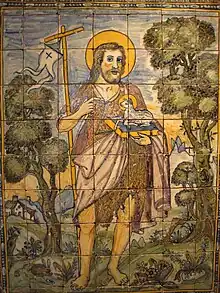Penha de França
Penha de França (Portuguese pronunciation: [ˈpɐɲɐ ðɨ ˈfɾɐ̃sɐ]) is a freguesia (civil parish) and typical quarter of Lisbon, the capital of Portugal. Located in the historic center of Lisbon, Penha de França is north of São Vicente, east of Arroios, south of Areeiro, and west of Beato. The population in 2021 was 28,475.[1]
Penha de França | |
|---|---|
_(cropped)_(cropped).jpg.webp) _(cropped).jpg.webp) .png.webp) .jpg.webp) .jpg.webp) .JPG.webp) Clockwise: Palace of the Marquises of Nisa; Penha de França Church; Alto de São João Cemetery; Manueline portal; National Museum of the Azulejo; Madre de Deus Park | |
 Coat of arms | |
_localiza%C3%A7%C3%A3o.svg.png.webp) | |
| Coordinates: 38.729°N 9.131°W | |
| Country | |
| Region | Lisbon |
| Metropolitan area | Lisbon |
| District | Lisbon |
| Municipality | Lisbon |
| Area | |
| • Total | 2.71 km2 (1.05 sq mi) |
| Population (2021) | |
| • Total | 28,475 |
| • Density | 11,000/km2 (27,000/sq mi) |
| Time zone | UTC±00:00 (WET) |
| • Summer (DST) | UTC+01:00 (WEST) |
| Website | http://www.jf-penhafranca.pt/ |
History
The Madre de Deus Convent was founded in 1509 by Queen Leonor of Viseu.
On the other hand, the Convent of Penha de França, founded in 1598, lends its name to this parish. Its territory originated from medieval parishes: Santo Estêvão de Alfama, Santa Justa, and Olivais, within Lisbon's jurisdiction. Perched at 110 meters above sea level, it offers sweeping city views.
In the 16th century, residential areas emerged around the convents, the Royal Palace, and the Mitra. In the 17th century, development centered around the Church of Penha de França and the Convent (now the General Command of the PSP).
The 1755 earthquake led to the abandonment of estates (Pina, Coxo, Bacalhau, among others) and manors (Gadanho, Peixinhos, Alto da Eira, Santo António, and Machada).
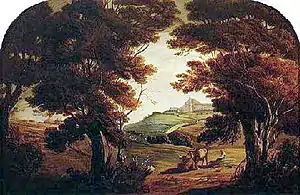
In the 19th century, factories sprang up in the valleys of Chelas and Xabregas while maintaining a rustic character. It remained a favored area for Lisbon residents to stroll, as described by Almeida Garrett in "Viagens na Minha Terra".
Penha de França's traditions include the "Forrolho Procession", a nighttime event where doors were knocked with a ferrolho (latch) to awaken the devout.[2]
Commissioned by Queen Maria II in 1833 following a cholera epidemic in Lisbon, the Alto de São João Cemetery served as the city's cemetery for over a century, honoring its most distinguished figures.
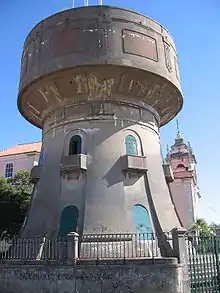
The freguesia of Penha de França was created on April 13, 1918. and in 1925 the country's first crematorium was built in the parish.
In 1959 its area was reduced in order to create the parishes of Alto do Pina and São João, while it has housed the National Museum of the Azulejo since 1965 in the Madre de Deus Convent.
With the 2012 Administrative Reform, the parish of São João merged with Penha de França and the new and larger parish kept its name.[3]
The parish hosts the Portuguese Camping and Mountaineering Federation and, on a bimestral basis, hosts the Penha de França Theme Fair.[4][5] The parish features also three public libraries - with the last one being opened in 2015 - many cultural associations such as ""Os fidalgos da Penha", a large municipal market (Mercado de Sapadores) and art galleries.[6][7][8][9][10][11][12]
Landmarks


_-_Named_%22Hunting_Room%22_from_the_scenes_represented_in_the_panels_animals_chasing_each_other_(29658298078).jpg.webp)
.png.webp)
- Alto de São João Cemetery: Including the Jazigo Viscondes de Valmor, it was established in 1833 during a cholera epidemic it was located in the rural outskirts and holds a diverse history. Its architecture includes works by renowned architects and anonymous builders. The cemetery pays tribute to Republican revolutionaries, features mausoleums dedicated to benefactors and women activists, and housed Portugal's first crematorium in 1925, later reactivated in 1985. Notable figures like Nobel laureate José Saramago and politician Álvaro Cunhal were cremated here.[13]
- Chafariz da Penha de França: 1870 fountain[14][15]
- Chafariz do Alto do Pina: Ancient fountain[16]
- Edifício na Rua dos Baldaques, 13: Building from 1932 that won the Eugénio dos Santos architecture prize[17]
- Fort Santa Apolónia or Baluarte de Santa Apolónia: built between 1652 and 1668, defended the eastern part of Lisbon. Its pentagonal design, facing east and west, includes well-preserved features like masonry walls, watchtowers, and gates. Classified as a Property of Public Interest, it was part of a riverside defensive line.[18]
- Forte de Santa Apolónia geomonument: In the Middle Miocene, the area around Lisbon served as an estuary for a major river, where fresh water mingled with the saltwater from the sea. Within this transitional setting, abundant in organic material, substantial populations of Gryphaea gryphoides oysters took root, with some of these oysters growing to impressive lengths of up to 40 cm.[19][20]
- Igreja Paroquial de São Francisco de Assis: Church inaugurated in 1959[21][22][23]
- Igreja São João Evangelista: Catholic church inaugurated in 1989[24]
- Madre de Deus Convent and church: Founded in 1509 by Queen D. Leonor, the Convent showcases diverse architectural styles, including Mudéjar, Manueline, Mannerist, Baroque, and Revivalist. It houses the National Tile Museum, displaying a rich collection of tiles from various eras. The church's simple façade features a notable 19th-century Neo-Manueline portal. Inside, the single nave is adorned with 18th-century historical azulejos depicting the life of St. Francis, and the main chapel and choir boast 16th-century paintings framed in gilt woodwork[25]
- Miradouro da Penha de França: An unforgettable view encompasses both the Tagus Valley, where the horizon meets the Atlantic Ocean, and the opposite direction, offering a glimpse of Alto de São João and much of both riverbanks. To the north, the distant presence of the Sintra Mountain Range can be seen[26]
- National Museum of the Azulejo: Housed in the Convent of the Mother of God, this museum showcases Portuguese azulejos from the 15th to the 20th century, including notable pieces like the Altarpiece of Our Lady of Life and modern works[27][28][29][30]
- Nossa Senhora da Penha de França Church and convent: The first chapel with this dedication emerged following a vow made by the visionary António Simões after the Battle of Alcácer Quibir. Construction began in 1597-98. In 1601, it was handed over to the Augustinian hermits. Between 1625 and 1635, a new temple was built to replace the previous one. It underwent several renovations, notably in the 18th century[31][32]
- Painel de azulejos na fachada da Escola António Arroio: A 1999 polychrome tile panel, 1180 cm x 900 cm, by Master Querubim Lapa, graces the exterior façade of António Arroio School. It features a deconstructed, abstract design with vibrant contrasts[33]
- Palace of the Marquises of Nisa: Founded in 1543 by D. Francisco da Câmara, the second Count of Vidigueira, this building passed through various owners, including descendants of Vasco da Gama in 1634. It returned to the possession of the Marquises of Nisa in 1672 and underwent significant improvements at that time. Altered substantially from its original structure, both by the earthquake and the interventions of successive owners, it was sold to the Misericórdia de Lisboa in 1926[34]
- Priorado de São Pio X: Catholich church[35]
- Santos-o-Novo convent: Built in the early 17th century for the Order of Santiago, this imposing structure survived partial destruction in the 1755 earthquake.
It includes a vast cloister, ornate chapels, and gilded woodwork[36]
Streets
.jpg.webp)
.jpg.webp)
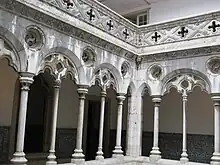
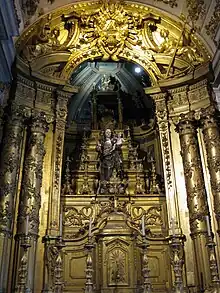
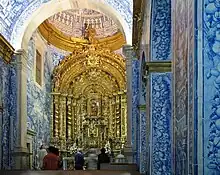
The parish has 118 streets.[37] They are:
- Alameda Dom Afonso Henriques
- Alto do Varejão
- Avenida Afonso III
- Avenida Coronel Eduardo Galhardo
- Avenida General Roçadas
- Avenida Infante Dom Henrique
- Avenida Marechal Francisco da Costa Gomes
- Avenida Mouzinho de Albuquerque
- Azinhaga da Fonte do Louro
- Azinhaga do Alto do Varejão
- Calçada da Cruz da Pedra
- Calçada da Ladeira
- Calçada das Lajes
- Calçada do Poço dos Mouros
- Caminho de Baixo da Penha
- Caminho do Alto do Varejão
- Estrada de Chelas
- Jardim Luís Ferreira
- Largo Alferes Francisco Duarte
- Largo da Penha de França
- Largo de Santos o Novo
- Largo do Marquês de Nisa
- Largo Mendonça e Costa
- Parada do Alto de São João
- Praça Aires de Ornelas
- Praça Aniceto do Rosário
- Praça António Sardinha
- Praça Dr. Ernesto Roma
- Praça João de Azevedo Coutinho
- Praça Paiva Couceiro
- Praceta do Alto do Varejão
- Rotunda das Olaias
- Rua Actor Joaquim de Almeida
- Rua Actor Vale
- Rua Adolfo Coelho
- Rua Álvaro de Santa Rita Vaz
- Rua Angelina Vidal
- Rua António Gonçalves
- Rua António Luís Inácio
- Rua António Maria Baptista
- Rua Artur de Paiva
- Rua Augusto José Vieira
- Rua Barão de Sabrosa
- Rua Bispo de Cochim
- Rua Borges Graínha
- Rua Braamcamp Freire
- Rua Carlos Ribeiro
- Rua Carrilho Videira
- Rua Carvalho Araújo
- Rua Castelo Branco Saraiva
- Rua Cesário Verde
- Rua Cidade de Cardiff
- Rua Cidade de Liverpool
- Rua Cidade de Manchester
- Rua Conde de Monsaraz
- Rua Coronel Ferreira do Amaral
- Rua Coronel Luna de Oliveira
- Rua Cristóvão Falcão
- Rua da Graça
- Rua da Madre de Deus
- Rua da Penha de França
- Rua das Enfermeiras da Grande Guerra
- Rua David Lopes
- Rua de Santa Apolónia
- Rua de Xabregas
- Rua do Barão de Monte Pedral
- Rua do Cruzado Osberno
- Rua do Forte de Santa Apolónia
- Rua do Padre Sena de Freias
- Rua do Sol a Chelas
- Rua Dom Domingos Jardo
- Rua Dom Fuas Roupinho
- Rua dos Baldaques
- Rua dos Heróis de Quionga
- Rua dos Sapadores
- Rua Dr. Lacerda e Almeida
- Rua Dr. Oliveira Ramos
- Rua Edith Cavell
- Rua Eduardo Costa
- Rua Emília Eduarda
- Rua Engenheiro Santos Simões
- Rua Estácio da Veiga
- Rua Feio Terenas
- Rua Francisco Pedro Curado
- Rua Frei Manuel do Cenáculo
- Rua General Themudo Barata
- Rua Gualdim Pais
- Rua Heliodoro Salgado
- Rua Henrique Barrilaro Ruas
- Rua Jacinto Nunes
- Rua José Inácio de Andrade
- Rua José Sobral Cid
- Rua Joseph Piel
- Rua Lopes
- Rua Luís Monteiro
- Rua Maria da Fonte
- Rua Marques da Silva
- Rua Martins Sarmento
- Rua Matilde Rosa Araújo
- Rua Melo Gouveia
- Rua Mestre António Martins
- Rua Morais Soares
- Rua Nélson de Barros
- Rua Néry Delgado
- Rua Neves Ferreira
- Rua Paio Peres Correia
- Rua Poeta Milton
- Rua Professor Celestino da Costa
- Rua Quatro de Agosto
- Rua Sabino de Sousa
- Rua Sebastião Saraiva Lima
- Rua Sousa Viterbo
- Rua Teixeira Pinto
- Rua Triângulo Vermelho
- Rua Visconde de Juromenha
- Travessa da Amorosa
- Travessa do Alto do Varejão
- Travessa do Calado
- Alto da Eira
- Caminho Quinta dos Peixinhos
- Pátio Saraiva (Rua Sebastião Saraiva Lima)
- Praceta Carlos Ribeiro
- Rua de Baixo (Rua Particular à Rua Castelo Branco Saraiva)
- Rua de Cima (Rua Particular à Rua Castelo Branco Saraiva)
- Rua do Alto da Eira
- Rua Particular (Rua Castelo Branco Saraiva)
- Rua Particular (Rua Frei Manuel do Cenáculo)
- Rua Particular (Rua Sebastião Saraiva Lima)
- Vila Amaral (Rua Mestre António Martins, 29)
- Vila Branca (Rua Particular à Rua Frei Manuel do Cenáculo, 10)
- Vila Cândida (Avenida General Roçadas, 24)
- Vila Celeste (Rua Professor Celestino Costa 15 e 18)
- Vila Duarte (Rua dos Heróis de Quionga, 62A)
- Vila Esteves (Rua Particular à Rua Frei Manuel do Cenáculo, E)
- Vila Gadanho (Rua Castelo Branco Saraiva, 38)
- Vila Gomes (Rua Marques da Silva, 45)
- Vila Guilherme Rodrigues (Rua Heliodoro Salgado, 48)
- Vila Janeira (Rua Marques da Silva, 15)
- Vila Manuel Bernardes (Rua Marques da Silva)
- Vila Piedade (Rua Heróis de Quionga, 60)
- Vila Rossário (Rua da Penha de França, 138)
- Vila Saraiva (Calçada Poço dos Mouros, 7)
- Vila Silvério (Rua Marques da Silva, 2A)
References
- INE. "Indicador". tabulador.ine.pt. Retrieved 2023-10-08.
- "História da Freguesia".
- Diário de Notícias newspaper. "List of new parishes" (pdf) (in Portuguese). Retrieved 27 October 2013.
- "Federação de Campismo e Montanhismo de Portugal".
- "Feira Temática Penha de França".
- "Biblioteca da Penha de França".
- "Biblioteca Museu Nacional do Azulejo".
- "Biblioteca da Associação Portuguesa de Bibliotecários, Arquivistas e Documentalistas".
- "Loja Social Os Fidalgos da Penha".
- "Mercado de Sapadores".
- "The Switch".
- "Projeto Troca Amiga".
- "Jazigo Viscondes de Valmor". informacoeseservicos.lisboa.pt (in European Portuguese). Retrieved 2023-10-08.
- "Diretório da Cidade". informacoeseservicos.lisboa.pt (in European Portuguese). Retrieved 2023-10-08.
- "Cemitério do Alto de São João".
- "Diretório da Cidade". informacoeseservicos.lisboa.pt (in European Portuguese). Retrieved 2023-10-08.
- "Rua dos Baldaques".
- "Forte ou Baluarte de Santa Apolónia".
- "Geomonumento Forte de Santa Apolónia" (PDF).
- "Geomonumento do Forte de Santa Apolónia".
- "Patriarcado de Lisboa". www.patriarcado-lisboa.pt. Retrieved 2023-10-08.
- "São Francisco de Assis". Quo Vadis Lisboa (in Portuguese). Retrieved 2023-10-08.
- "Igreja Paroquial de São Francisco de Assis".
- "São João Evangelista". Quo Vadis Lisboa (in Portuguese). Retrieved 2023-10-08.
- "Convento da Madre de Deus".
- "Miradouro da Penha de França".
- "Museu Nacional do Azulejo".
- T: +351 210 312 700; F: +351 210 312 899; Atl@visitlisboa.com; Www.visitlisboa.com. "Museu Nacional do Azulejo". Turismo de Lisboa (in European Portuguese). Retrieved 2023-10-08.
- "DGPC | Museus e Monumentos | Rede Portuguesa de Museus | Museu Nacional do Azulejo". www.patrimoniocultural.gov.pt. Retrieved 2023-10-08.
- "DGPC | Museu Nacional do Azulejo". www.patrimoniocultural.gov.pt. Retrieved 2023-10-08.
- "Igreja Paroquial da Penha de França".
- "Edifício do antigo Convento de Nossa Senhora da Penha de França".
- "Painel de azulejos na fachada da Escola António Arroio".
- "Palácio dos Marqueses de Nisa".
- "priorados".
- "Convento de Santos-o-Novo".
- Câmara Municipal de Lisboa (CML) - Toponímia de Lisboa
.jpg.webp)
